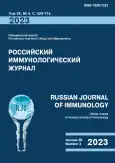Immunobiology of lymphotoxin: role in a mouse model of multiple sclerosis
- Authors: Gogoleva V.S.1, Drutskaya M.S.1,2, Nedospasov S.A.1,2
-
Affiliations:
- Engelhardt Institute of Molecular Biology, Russian Academy of Sciences
- Sirius University of Science and Technology
- Issue: Vol 26, No 4 (2023)
- Pages: 437-442
- Section: Forum Sochi 2023
- URL: https://journals.rcsi.science/1028-7221/article/view/253424
- DOI: https://doi.org/10.46235/1028-7221-13534-IOL
- ID: 253424
Cite item
Full Text
Abstract
Complex immunobiology of lymphotoxin (LTα) is due to multiple modalities of signal transduction, involving a soluble homotrimer and membrane-bound heterotrimers that engage at least three different receptors. While LTα is crucial for the formation and maintenance of secondary lymphoid organs, its overproduction is observed in autoimmune diseases such as rheumatoid arthritis and multiple sclerosis. Initially, LTα was considered pathogenic in the development of experimental autoimmune encephalomyelitis (EAE), a mouse model of multiple sclerosis, as demonstrated by the resistance of mice with genetic LTα inactivation to EAE induction. However, conflicting observations arose when EAE was induced in RAG1-deficient mice that underwent adoptive bone marrow transfer from LTα-deficient mice, thereby calling into question previous conclusions about the role of LTα in EAE development.
This study aimed to investigate the role of LTα in MOG35-55-induced EAE using mice deficient in LTα or its membrane receptor, LTβR. LTα knockout mice used here were designed to avoid the artifact involving TNF gene downregulation in myeloid cells, which occurred in the conventional LTα knockout mice.
Surprisingly, LTα-deficient mice with normal TNF expression developed EAE clinically comparable to wild-type mice. Conversely, genetic inactivation of LTβR delayed EAE onset. However, during the later stages of the disease, LTβR deletion exacerbated clinical symptoms of EAE.
These findings demonstrate that the involvement of LTα in EAE development is more complex than previously estimated, and that LTβR exhibits diverse functions depending on the disease stage: pathogenic at the early stage and protective at the later stages of EAE.
Keywords
Full Text
##article.viewOnOriginalSite##About the authors
V. S. Gogoleva
Engelhardt Institute of Molecular Biology, Russian Academy of Sciences
Email: violettegogoleva@mail.ru
Junior Research Associate, Center for Precision Genome Editing and Genetic Technologies for Biomedicine, Engelhardt Institute of Molecular Biology, Russian Academy of Sciences
Russian Federation, MoscowM. S. Drutskaya
Engelhardt Institute of Molecular Biology, Russian Academy of Sciences; Sirius University of Science and Technology
Email: marinadru@gmail.com
PhD, MD (Biology), Leading Research Associate, Center for Precision Genome Editing and Genetic Technologies for Biomedicine, Engelhardt Institute of Molecular Biology, Russian Academy of Sciences, Moscow; Assistant Professor, Sirius University of Science and Technology
Russian Federation, Moscow; Krasnodar RegionSergei A. Nedospasov
Engelhardt Institute of Molecular Biology, Russian Academy of Sciences; Sirius University of Science and Technology
Author for correspondence.
Email: sergei.nedospasov@gmail.com
PhD, MD (Biology), Professor, Full Member, Russian Academy of Sciences, Head, Laboratory of Molecular Mechanisms of Immunity, Engelhardt Institute of Molecular Biology, Russian Academy of Sciences, Moscow; Head, Division of Immunobiology and Biomedicine, Sirius University of Science and Technology
Russian Federation, Moscow; Krasnodar RegionReferences
- Aggarwal B.B., Moffat B., Harkins R.N. Human lymphotoxin. Production by a lymphoblastoid cell line, purification, and initial characterization. J. Biol. Chem., 1984, Vol. 259, no. 1, pp. 686-691.
- Browning J.L., Ngam-ek A., Lawton P., deMarinis J., Tizard R., Chow E.P., Hession C., O’Brine-Greco B., Foley S.F., Ware C.F. Lymphotoxin beta, a novel member of the TNF family that forms a heteromeric complex with lymphotoxin on the cell surface. Cell, 1993, Vol. 72, no. 6, pp. 847-856.
- Crowe P.D., VanArsdale T.L., Walter B.N., Ware C.F., Hession C., Ehrenfels B., Browning J.L., Din W.S., Goodwin R.G., Smith C.A. A lymphotoxin-beta-specific receptor. Science, 1994, Vol. 264, no. 5159, pp. 707-710.
- de Togni P., Goellner J., Ruddle N.H., Streeter P.R., Fick A., Mariathasan S., Smith S.C., Carlson R., Shornick L.P., Strauss-Schoenberger J., Russell J.H., Karr R., Chaplin D.D. Abnormal development of peripheral lymphoid organs in mice deficient in lymphotoxin. Science, 1994, Vol. 264, no. 5159, pp. 703-707.
- Futterer A., Mink K., Luz A., Kosco-Vilbois M.H., Pfeffer K. The lymphotoxin beta receptor controls organogenesis and affinity maturation in peripheral lymphoid tissues. Immunity, 1998, Vol. 9, no. 1, pp. 59-70.
- Granger G.A., Williams T.W. Lymphocyte cytotoxicity in vitro: activation and release of a cytotoxic factor. Nature, 1968, Vol. 218, no. 5148, pp. 1253-1254.
- Gray P.W., Aggarwal B.B., Benton C.V., Bringman T.S., Henzel W.J., Jarrett J.A., Leung D.W., Moffat B., Ng P., Svedersky L.P. Cloning and expression of cDNA for human lymphotoxin, a lymphokine with tumour necrosis activity. Nature, 1984, Vol. 312, no. 5996, pp. 721-724.
- Liepinsh D.J., Grivennikov S.I., Klarmann K.D., Lagarkova M.A., Drutskaya M.S., Lockett S.J., Tessarollo L., McAuliffe M., Keller J.R., Kuprash D.V., Nedospasov S.A. Novel lymphotoxin alpha (LTalpha) knockout mice with unperturbed tumor necrosis factor expression: reassessing LTalpha biological functions. Mol. Cell. Biol., 2006, Vol. 26, no. 11, pp. 4214-4225.
- Mana P., Linares D., Silva D.G., Fordham S., Scheu S., Pfeffer K., Staykova M., Bertram E.M. LIGHT (TNFSF14/CD258) is a decisive factor for recovery from experimental autoimmune encephalomyelitis. J. Immunol., 2013, Vol. 191, no. 1, pp. 154-163.
- Ruddle N.H., Waksman B.H. Cytotoxicity mediated by soluble antigen and lymphocytes in delayed hypersensitivity. 3. Analysis of mechanism. J. Exp. Med., 1968, Vol. 128, no. 6, pp. 1267-1279.
- Ruddle N.H., Bergman C.M., McGrath K.M., Lingenheld E.G., Grunnet M.L., Padula S.J., Clark R.B. An antibody to lymphotoxin and tumor necrosis factor prevents transfer of experimental allergic encephalomyelitis. J. Exp. Med., 1990, Vol. 172, no. 4, pp. 1193-1200.
- Suen W.E., Bergman C.M., Hjelmstrom P., Ruddle N.H. A critical role for lymphotoxin in experimental allergic encephalomyelitis. J. Exp. Med., 1997, Vol. 186, no. 8, pp. 1233-1240.
Supplementary files








